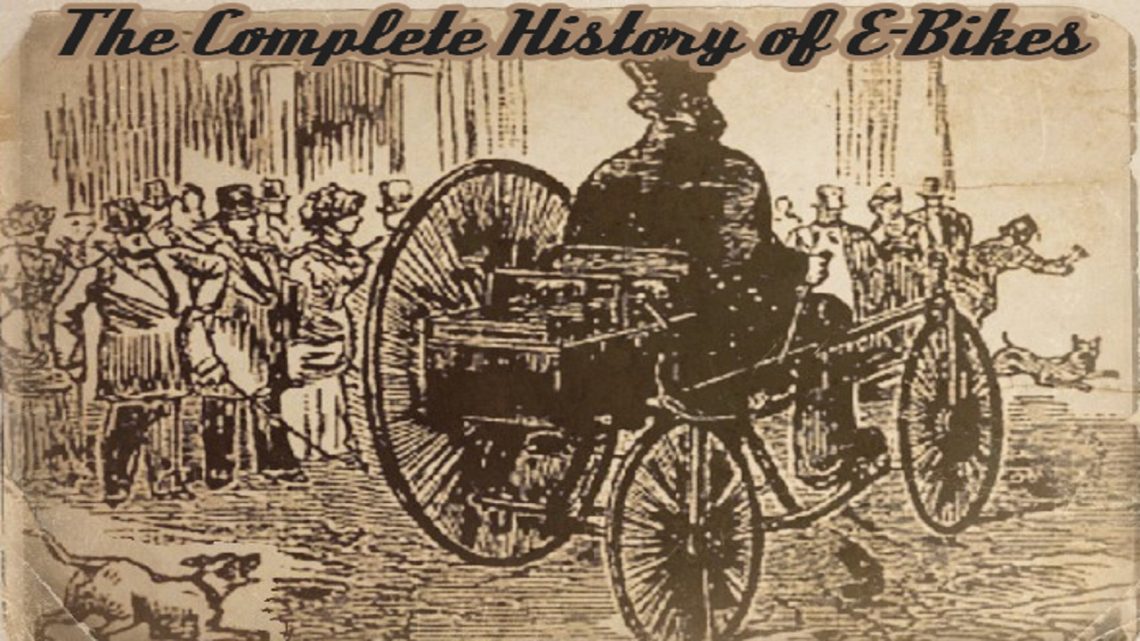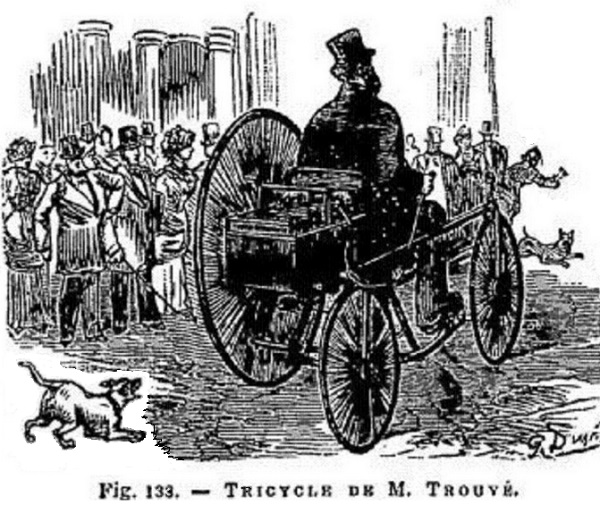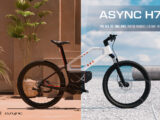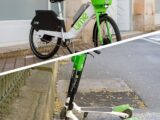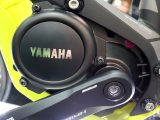There have been many different kinds of e-bikes over the years with e-bike patents going all the way back to the 1800s! So when we are talking about the complete history of e-bikes it is always best to start at the first patent, no matter how weird and obscure it is. The history of the e-bike is made by brilliant and passionate (maybe even a little crazy) inventors that have willfully chased their dream of an electrified bicycle. Sadly they have seen it fail many times over, sometimes even tragically.
In recent years, those failures have been turning into an amazing reality at a great rate. Only a few people know that the humble e-bike’s history surprisingly goes all the way back to the 1800s, since the introduction of the first velocipedes, inventors and engineers have been trying to turn them into steam-engine powered bicycles. So as you might imagine it is a long journey through history to get to something you might call a modern-day e-bike, but that trip through history is an interesting one we promise…
1880: Trouvé Tricycle
So we start this journey to the modern-day e-bike in 1880 when French electrical engineer and inventor Gustave Trouvé improved the efficiency of a small electric motor developed by Siemens and using the recently developed rechargeable battery, fitted it to an English James Starley tricycle, so inventing the world’s first electric vehicle. Although this was successfully tested on 19 April 1881 along the Rue Valois in central Paris, he was unable to patent it.
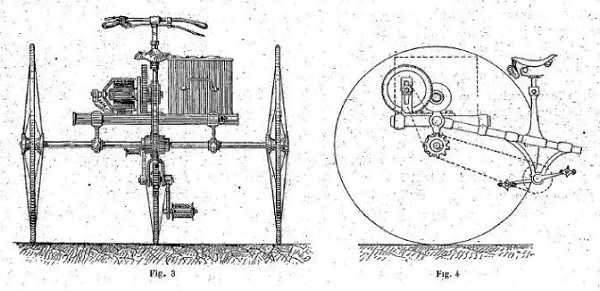
1892: Graffigny Tricycle
Moving forward a few years now we come to 1892 when Mme de Graffigny invented a peddleable electric tricycle. The output gear of the motor is connected to the differential device of the human drive wheel through a series of reduction gear sets. Therefore, this tricycle can be driven either by the rider on the pedals or by an electric motor. On the right side of the vehicle is a box of 24 batteries and on the left side is a nearly 10kg motor pack, but it weighed just over 77kg meaning it wasn’t exactly energy efficient.
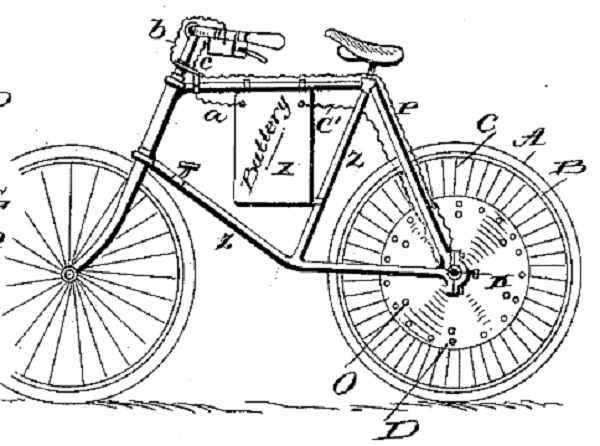
1895: Ogden Bolton
Steam-powered e-bikes/motorbikes never really had any success, but at the end of the 19th century there were two promising propulsion systems: those based on oil and those based on electricity. Engineers were mostly working on carriages, which would have soon turned into proper cars, but during those years, another American inventor decided to build a bike with an electric motor. His name was Ogden Bolton Junior. We know very little about him: he registered a patent in an American office in 1895, and that’s all we know.
Ogden Bolton’s idea was simple but quite interesting: he installed an electric motor on a bike’s rear wheel hub. It was a DC motor with 6 poles, it could take up to 100 amps from a 10 volt battery. The battery was placed under the horizontal tube of the frame. There was no gearing system so we can imagine it had a very high torque and a low battery life (there weren’t pedals to help the motor either).
1896 James O’Brien
Moving forward just a single year and we come across this obscure reference to an electric bicycle built in New York by James O’Brien in 1896. O’Brien was born in Ireland in County Kings (since renamed) where he attended common schools, then immigrated to the United States in 1861. The patent states that there is a small motor located just under the seat and it states ‘a woven silk belt’ drives the hub of the rear wheel. It all sounds rather posh to us, but we thought it was noteworthy anyway.
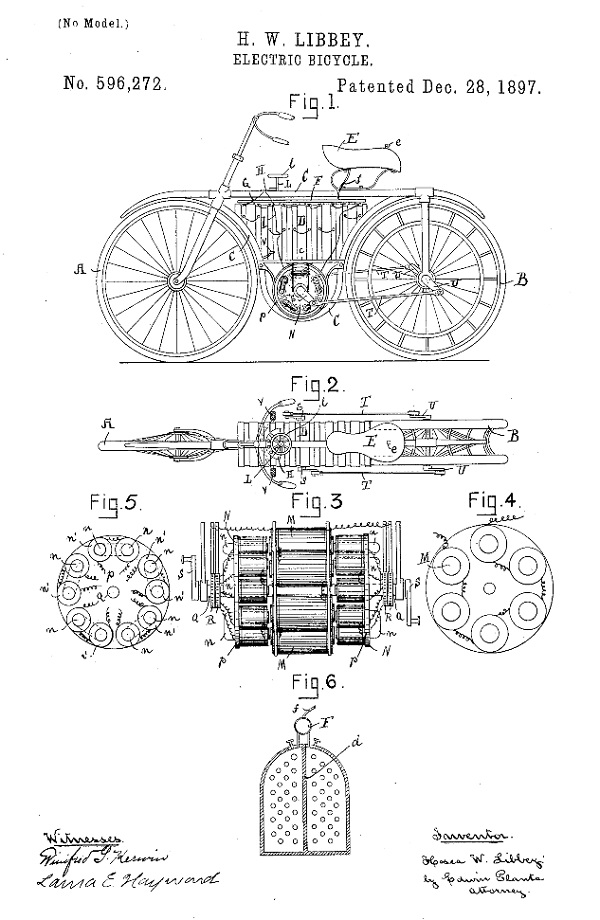
1897 Hosea W. Libbey
Just one year later and we are already looking at a mid-drive e-bike. Sure it doesn’t have any pedals, but you are definitely seeing an early version of the electric bike in 1897. The electric motor is separated from the wheel, making the dynamo free to spin faster than the wheel. This means that a smaller non-hub motor can provide as much power as a larger motor that is located in the wheel and it creates a lower point of balance that makes bicycling more natural. Unfortunately, this particular mid-drive only spins at the RPMs of the wheel, however, it does move the weight of the motor to the centre of the bike.
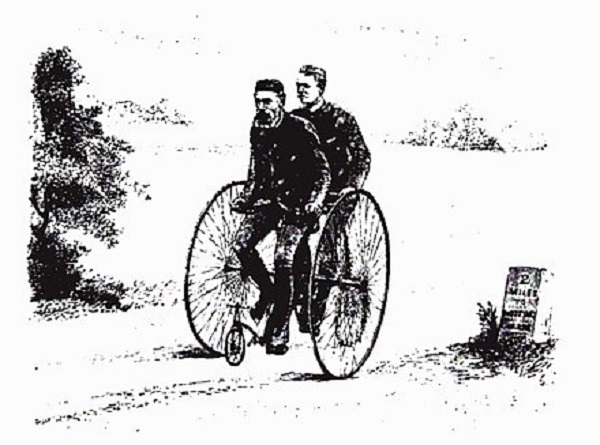
1897: Humber E-Tandem
This is not a patent, but an advertisement for the British 1897 Humber electric tandem. “The Humber Electric Tandem below, with four accumulators and an electric motor, plus pedal power from two riders, was exhibited at the Stanley Show in November 1897.” In fact, they exhibited 3 styles of the same bike ‘motor cycles, electric and oil’. The three electric-motor tandems were designed for pacing purposes, but they also showcase a three-wheel motor carriage at the same time. Sadly just a year later the owner Ernest Terah Hooley was bankrupted and the Humber company closed down its overseas operations.
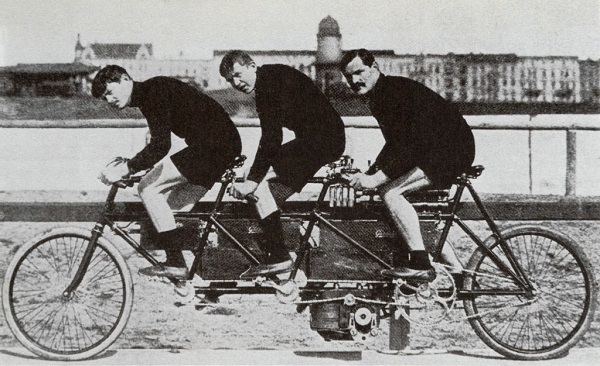
1898: The Jallu Brothers
It’s little known that internal-combustion pacers weren’t the first motorized pacers: electric-powered pacing cycles were among the first electric two-wheelers, and were a common sight in Europe in the racing season. In the 1898 World Championship in France, no less than 17 electric tandems and triples were present. This triple was built in 1898 by the Jallu brothers of France, and the riders are Jules Thé, Fritz Steger, and Marius Thé, who would move on to motorcycle racing in the 1900s wining several races in a row.
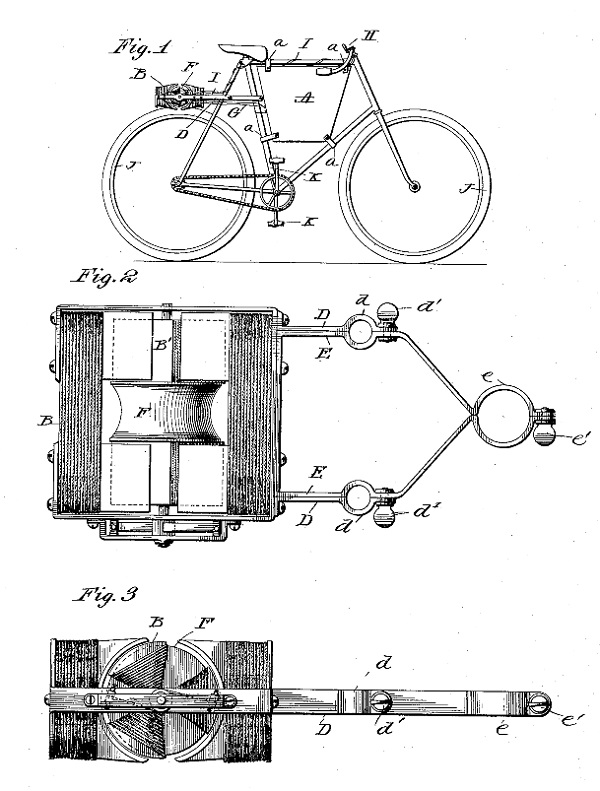
1899: John Schnepf
John Schnepf introduced a bicycle which used a pulley that rest on the top surface of the rear wheel. The pulley rotated with the help of the motor and in turn moved the wheel. There is a second page in the patent that has a 90-degree geared reduction to allow the motor to spin much faster than the roller (which theoretically would help efficiency), so he was a creative inventor for sure.
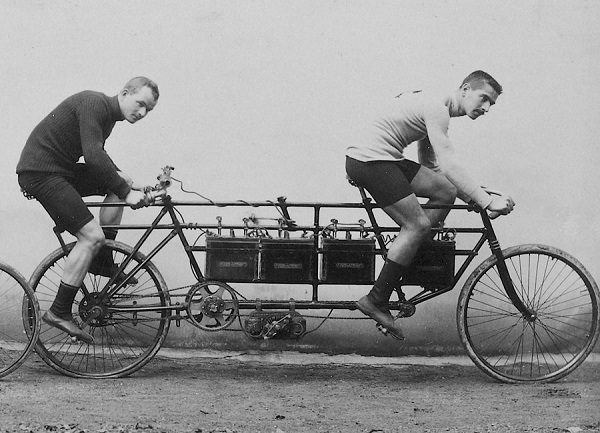
1900: French Electric Tandem
This tandem électrique was an invention of the Frenchmen de Clerc and Pingault and is ridden by the French bicycle racers Dacier and Jalabert. On May 22, 1897, this tandem rode one kilometre in 57 seconds. The tandem would not have been lightweight given those four huge batteries and probably very difficult to ride. You should also note the lack of any brakes!
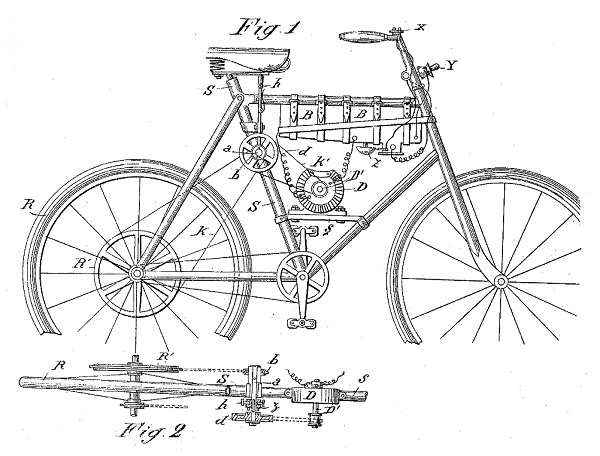
1900: Albert Hansel
In this same year, Albert Hansel was granted this patient that has two stages of reduction and uses a frame-mounted jackshaft to power the left side of the wheel. And, as if the patent above was not enough, Mr Hansel also patented a chain-less friction-drive, where the motor and the Bottom-Bracket (BB) sprocket share the jackshaft connection.
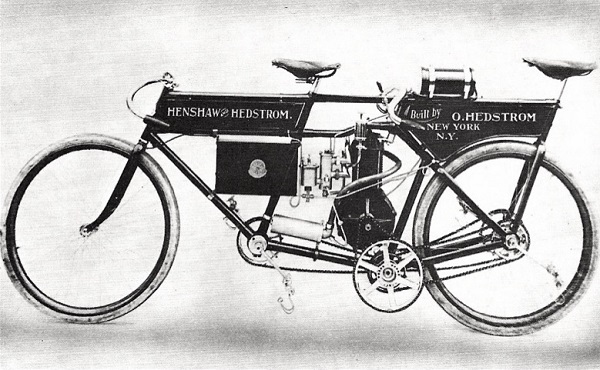
1901: Oscar Hedstrom’s Tandem
This amazing motor driven pacer cycle built by Oscar Hedstrom in 1900 with his business partner Charles Henshaw used a modified DeDion engine in a custom cycle chassis. Note the rear rider’s position aft of the rear axle, as close as possible to a following cyclist to provide a draft. This bike was booked to pace races at the Springfield Colosseum for the 1901 season.
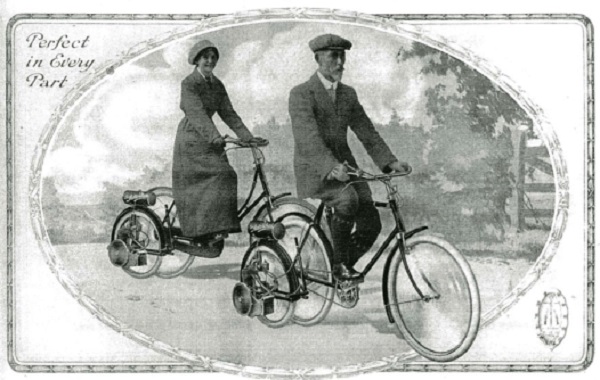
1909: The Worlds First E-bike Coversion Kit
Its smell was horrible and it was noisier than a landing jet, but it was absolute genius: we’re talking about Wall Auto-Wheel, the first conversion kit in history. The Auto-Wheel was produced by Autowheels Ltd, which was funded (among others) by Sir Arthur Conan Doyle, author of the Sherlock Holmes book series. The first model was presented in 1909 and it was a big hit: it allowed you to basically own a motorbike, but cheaper and relatively simply assembled.
In 1914 (the year when World War I started) Auto-Wheel was available in two models: a simple version (its price was 16 pounds and 16 shillings) and a Deluxe version (priced at 18 pounds and 18 shillings). The latter was decorated, unlike the simple version. It had protections to prevent the engine and mud from staining the frame or the cyclist. If you added 14 shillings on top of that you could get a shock absorber.
Unlike the other patents we talked about in the previous articles about the history of the electric bikes, Auto-Wheel was mass produced for a long time (at least until the end of the Twenties). That’s the reason why today enthusiastic collectors still own some models of this “motorbike”. The maximum speed allowed by the motor was 25 km/h on level ground; obviously, you could pedal if you wanted to go faster, though it would have been hard, considering the fact that the Auto-Wheel weighed 18 kg.
Belive it or not you can even watch a video of it here (notice the awful noise)…
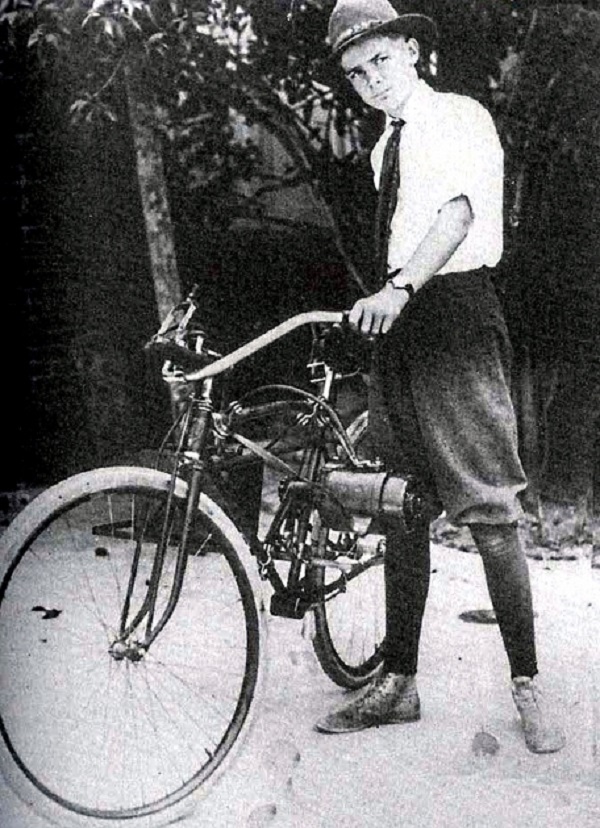
1917: Howard Hughes
While the first e-bike conversion kit in history was available it didn’t stop many other inventors from working hard in their basements. One of those people was the young Howard Hughes who mounted a motor on his bike in 1918, when he was just 13 years old. His story has been told in the 2004 movie The Aviator; Hughes was impersonated by Leonardo di Caprio. Howard’s favourite hobby was apparently riding his bike and disassembling any kind of objects and then putting the pieces together again in the back of his dad’s workshop. Apparently, Hughes Jr was so good that his dad bought him a car so that he could disassemble it and assemble it back together. His bike’s motor wasn’t electric though. We have to wait until 1920 to hear about electric bikes again.
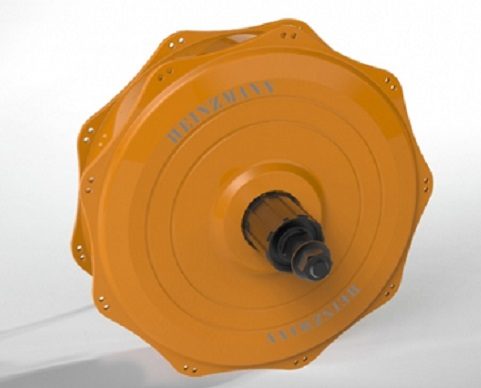
1920: The Heinzmann
In 1920 Heinzmann, a German company, started to mass produce electric motors for bikes. Their first motor was mounted on a tandem. Unfortunately, we don’t have much information about these models. Heinzmann never stopped producing electric motors for bikes (and for a number of other vehicles and tools). This company became known and grew its reputation of trustworthiness and quality over time. Their motors were very popular and they were even used for German post’s bikes. In fact, the company still produces e-bike systems today!
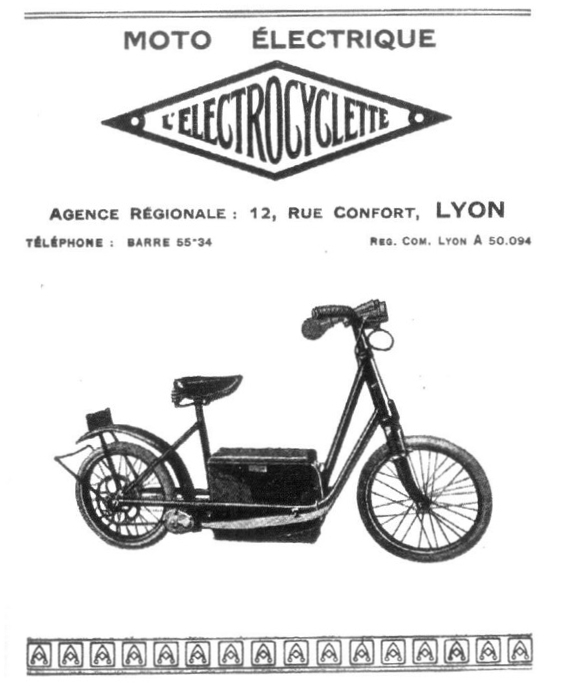
1927: The Electrocyclette
The rivalry between France and Germany was way more serious than engineering, and it had much more tragic consequences. Anyway, French people didn’t want to come second so they launched their own e-bike in 1927. Its name was a simple and effective “Electrocyclette”. The Electrocylcette was 1,8 meters long, it had a motor with 0,5 HP (for a maximum speed of 25 km/h). A battery of 150 Ah guaranteed a range of 30 km. Its weak point was the weight: a whopping 75 kg. A review of the time tells us that the battery was easily removable and that the Electrocyclette wasn’t noisy, it was cheap, small and fast. But there was still a long way to go until the modern e-bikes with pedalling assistance.
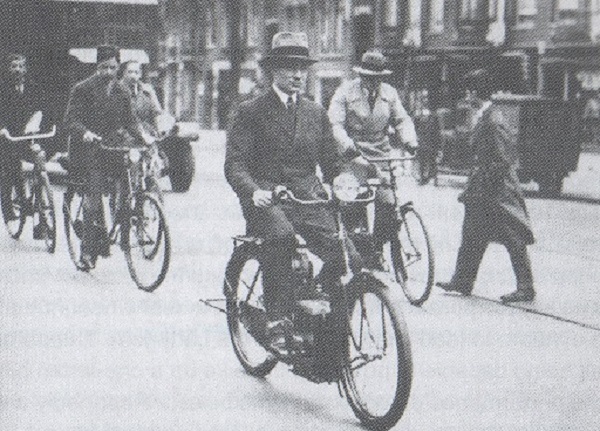
1932: The Philips Simplex Electric Bike
During the 30s e-bikes started to be something more than some bizarre creation of a visionary inventor. Many big European companies started producing proper e-bikes. Technology at the time didn’t allow for light vehicles with a long range, so e-bikes were the link between traditional bikes and the more reliable motorbikes with a combustion engine. Philips was already a very popular company at the time, especially in the radio sets field: in 1932 they had already sold a million radios all over the world. That year they decided to expand their market into the e-bikes field. They teamed up with Simplex (a company that produced regular bikes) to create this e-bike. The only thing we know about it is that it had a 12V battery.
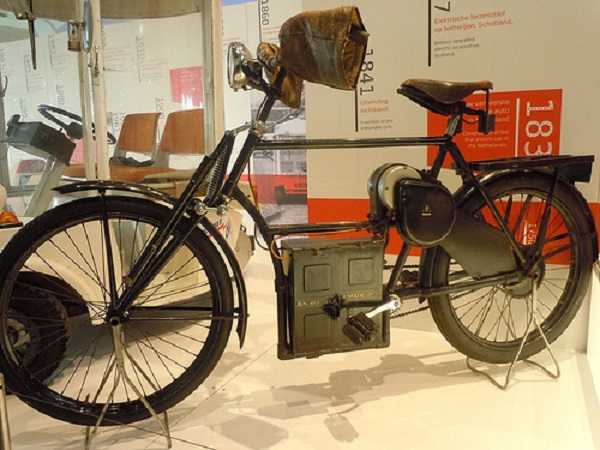
1933: The Juncker E-bike
The bike was 50kg without a battery. It took a whole day to recharge the battery and it only had a 40km range. This e-bike could only reach 18km/h in speed and they only produced 100 samples.
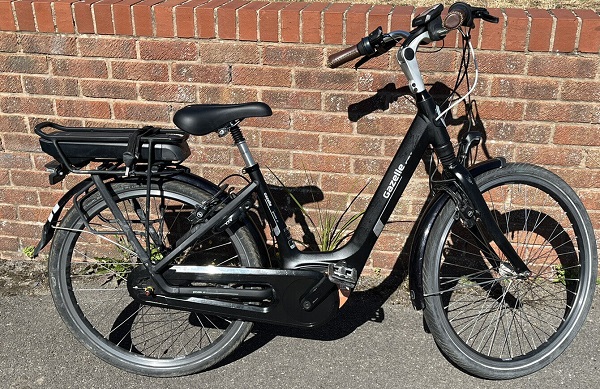
1937: The Philips Gazelle Ebike
In 1937 Philips tried again. This time they teamed up with Gazelle, one of the most successful companies in the bike trade in the Netherlands and in Europe. Gazelle is still in business today, and it has produced more than 13 million bikes so far. Unfortunately, the electric Gazelle was a flop and they only produced 117 samples.
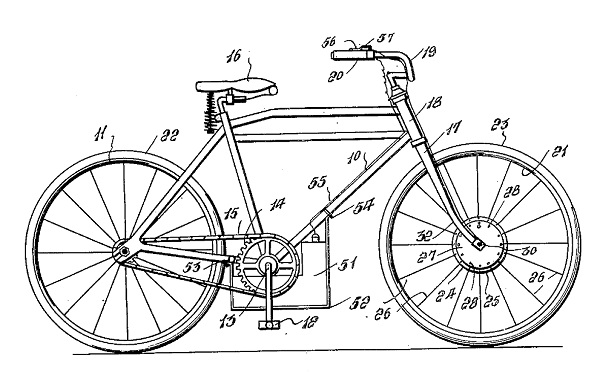
1938: T.M. McDonald
In 1938, not long before the United States declared war on Japan and Germany, Thomas M. McDonald filed PATENT US2179418 with the USPTO. It is aimed to provide such a bicycle, capable of operation by power alone and also capable of operation selectively, by the usual foot propulsion means. In addition, it is aimed to provide a novel electric motor and mounting in connection with the front wheel of the bicycle and novel means whereby the motor is maintained in gear with the front wheel or in braked relation and is further normally maintained in a neutral position.
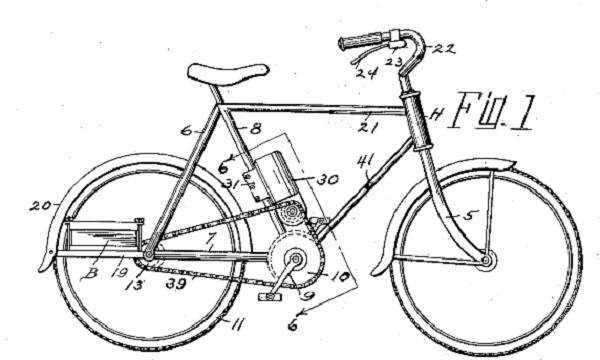
1946: Argyris Stefanos
The Second World War temporarily stopped the development of the industry. But at the same time, the fuel crisis has sparked increased interest in electric vehicles as an alternative to gasoline-powered vehicles. During this crisis, inventor Argyris Stefanos filed a patent that made a notable improvement to the existing technology. The motors’ drive-sprocket is mounted to a freewheel that is built into the system so the motor isn’t back-driven when the power is off and the bike is pedalled.
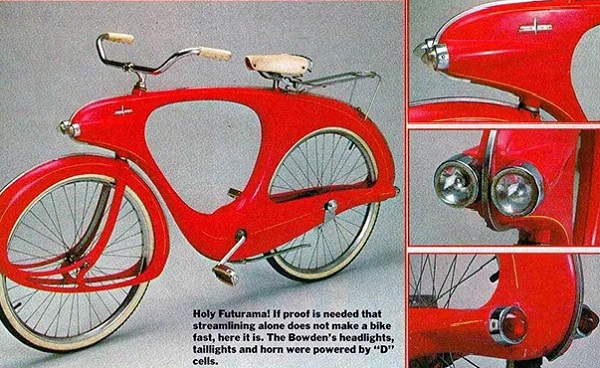
1946: Ben Bowdens “Bicycle of the Future!”
Ben Bowden was an Anglo-American designer who was popular in the car design field. In 1946 he tried something new: he created the “Bicycle of the Future”, which was an e-bike of course. We can see in the picture above how proud Ben was of his creation. The public was rather puzzled instead. The bike was very interesting on the technical side of things. The battery and the cables were internal to the frame. It had a hub motor on the back wheel that even worked as a dynamo to recharge the battery. From what we can read on the original patent, the bike could reach an 8 km/h speed on a 10% uphill slope. Bowden went back to designing cars. His Bicycle of the Future was too innovative for the time. During the Sixties, in the US, he managed to produce a bike that looked like his Bicycle of the Future, but without the motor.
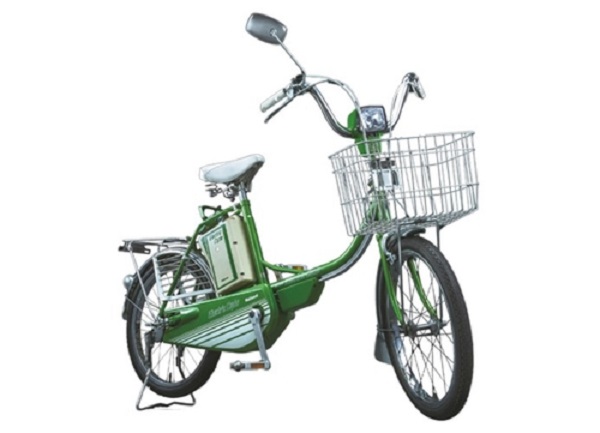
1975: Panasonic E-bike
The founder of Panasonic, Konuske Matsushita, personally introduced an electric bicycle in Japan in the early 70s, but the model was not mass-produced. Basically, it was the moment when Japanese technology entered the scene. The model was powered by a huge 24V lead-acid battery located under it, and the motor drive mechanism is located directly on the chain. The concept was similar to the one that appeared later in 1979 and belive it or not they still sell very similar-looking models of this e-bike today!
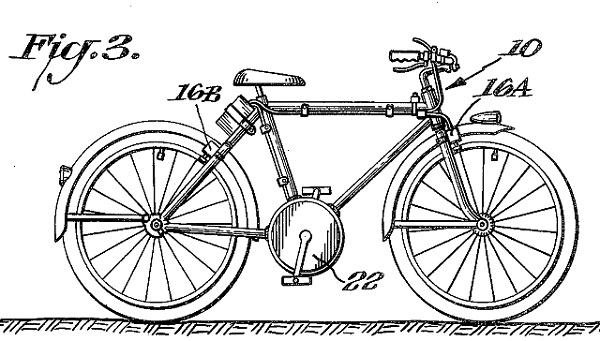
1975: Augustus B. Kinzel
The first publication known from Augustus Kinzel is US Patent 3’884’317. However, since there are no power electronics Kinzel’s version of the electrically powered cycle had difficulties starting and would only work at elevated speed of pedalling and rolling. A large generator is mounted in the bottom bracket and if you look closely, there is a tiny battery just behind the seat.
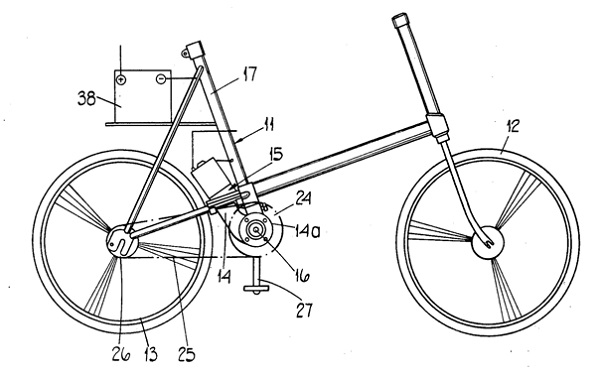
1977: Davidson-Leighton
This patent (Patent No. US4030562) from Charles P.D. Davidson and Peter W. Leighton features a compact drive with a cylindrical motor driving a 90-degree reduction and it incorporates a freewheel so the motor is not driven when you pedal with the motor unpowered.
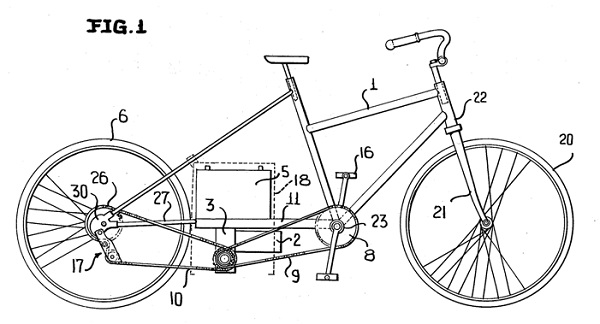
1981: Egon Gelhard
Gaining more notoriety, in 1982 the inventor Egon Gelhard developed a subtype of e-bikes that worked on the principle of bicilec or pedelec (pedal electric cycle) in which the driver is aided by electric traction of the motor when pedalling. This brought numerous methods to make this a great success.
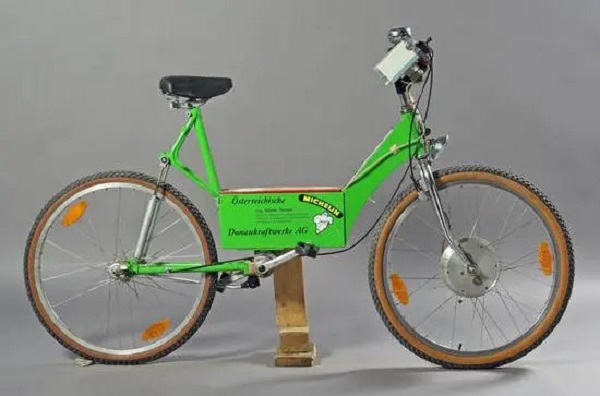
1989: Toriser
This eco-friendly e-bike is literally unique, being developed over a period of time as an experimental city commuter moped by Dr Toriser of Vienna’s Technical University. It was used very successfully in many competitions for electric vehicles, it is presented in its final form using a hub-centre motor.
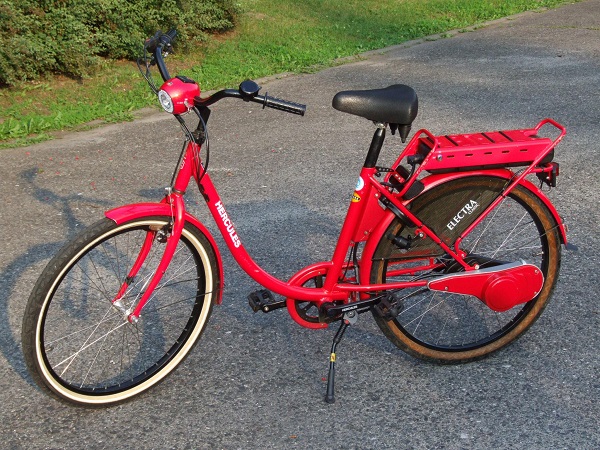
1989: Hercules
The Hercules Electra was the first vehicle registered in Germany as a light moped. In 1989, Hercules tested a pre-series of the Electra model. For this, as well as its internal combustion engine sister Saxonette, the company enforced the light moped regulation, also known as Lex Hercules, in Germany. It allowed these vehicles to be used at a maximum speed of 20 km/h without a helmet but they still required an insurance license plate. The ordinance was initially in its probationary period for three years. However, since the feared chaos of accidents did not occur, they were raised to law in 1991. The sales figures were quite impressive at first, but then came to a standstill relatively quickly. It was not possible to create an independent vehicle category that was accepted over the long term.
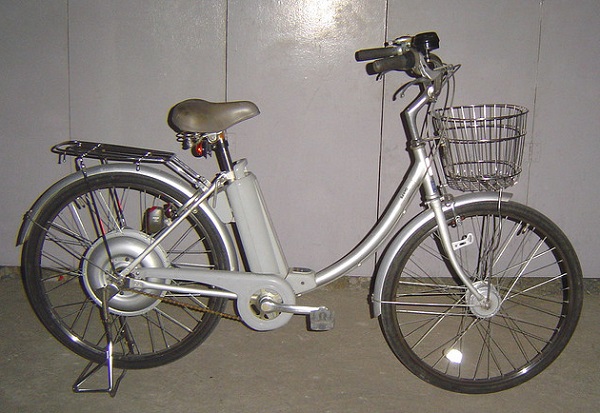
1989: Sanyo
In 1989 Sanyo produced the Enacle, which used NiCd batteries instead of lead-acid and that was a big advance at the time. The main problem was these bikes were still using lead-acid and NiCad batteries, respectively, which were heavier than the newer, lower-weight battery compositions. The benefits of new players in the world of e-bikes led to greater innovation and the creation of more electric bikes.
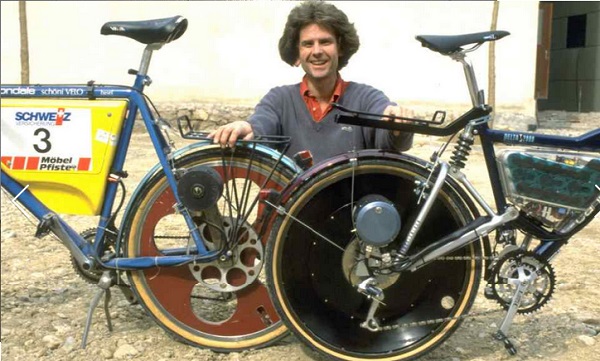
1990: Michael Kutter
In 1992 the first ‘Pedelec’ style e-bike combining human and battery power together – was created by Michael Kutter in Switzerland. The ‘descendants’ of his Velocity ‘Dolphin’ are finally becoming mainstream! You could say that this is the first Pedelec (PEDal-ELECtric). It later came to be referred to as Pedal Assist System (PAS), where there is no throttle, but the pedalling alone causes the motor to assist the rider.
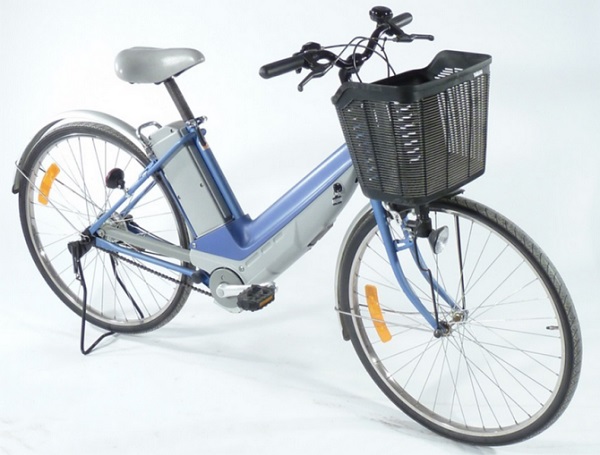
1993: Yamaha
Seeking to create “a commuter vehicle that put top priority on performance tuned to human perceptions,” Yamaha pioneered and developed the PAS (for Power Assist System), the world’s first electrically power-assisted bicycle. The PAS drive unit gives the appropriate amount of assist power from an electric motor based on the force applied to the pedals and was likened to “someone pushing your back,” even when riding up a hill or when riding with heavy loads. The Yamaha PAS created a whole new category of personal vehicle that required no helmet or driver’s license and was easy for anyone to use. )
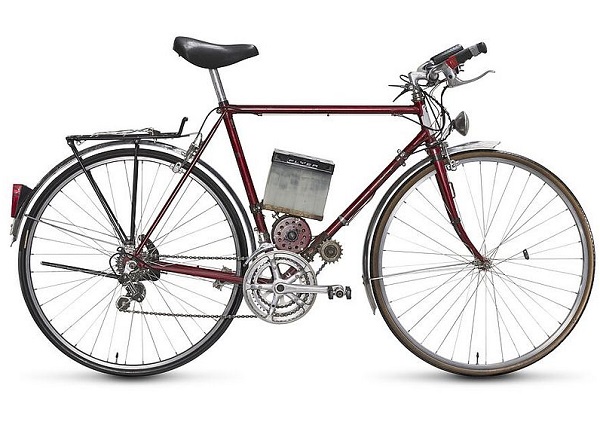
1993: The Red Buffalo
Philippe Kohlbrenner, a talented inventor from the Emmental valley, makes the electric bicycle marketable. He lived on the Lueg hill in the Emmental region and worked for a power engineering company at the bottom of the valley. Legend has it that his wife was such a good cook that he always wanted to ride home for lunch up the hill. However, at some point, the 300-metre difference in altitude got too much for him, which is why he had the idea of motorising his bicycle. To achieve this, he fitted a lorry windscreen wiper motor and a car battery. He used an ampere meter to control motor performance, while a simple flip switch on the handlebars served to start the “Red Buffalo”, whose name originated from the red-painted frame of this first FLYER e-bike and the aerodynamic handlebar position. FLYER still make e-bikes today and are still considered one of the best.
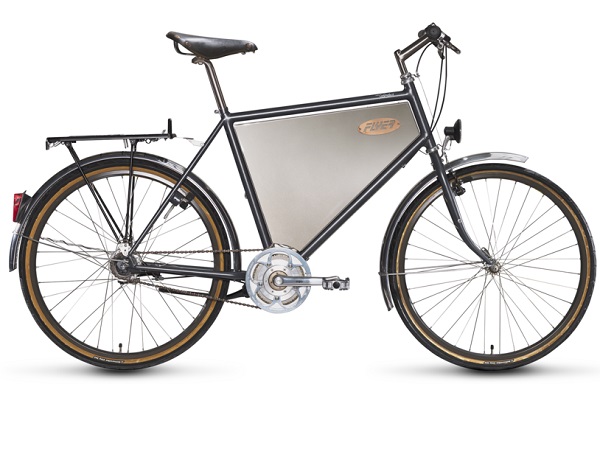
1995: FLYER Classic
The FLYER originated from a need to get around and was developed in several stages. After the first prototype of an electrified bicycle, “Red Buffalo” (“Roter Büffel”), hit the road in 1993, the company BKTech AG produced a small series of a first serial product from 1995 to 1999: the FLYER Classic. It incorporates a bottom-bracket-drive and a freewheeling chainring.
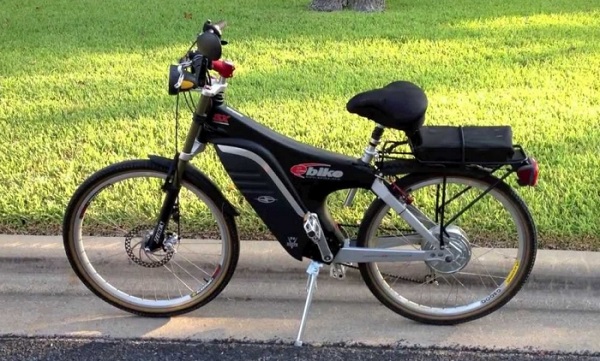
1999: EV Global
This e-bike was high-powered, feature-rich and way ahead of its time. It was designed by Lee Iacocca (the pioneering engineer behind classic Ford and Chevy automobiles) and featured a strong 500-watt geared rear hub motor by Heinzmann paired with a 36 volt SLA battery
By 2001 the terms e-bike, power bike, “pedelec”, pedal-assisted, and power-assisted bicycle were commonly used to refer to e-bikes. The terms “electric motorbike” or “e-motorbike” refer to more powerful models that attain up to 80 km/h (50 mph). Then here in 2021 10% to 20% of all two-wheeled vehicles sold were e-bikes of some kind.
Do Visit Many of These Sources Used…
- http://www.ebikeportal.com/history
- https://newatlas.com/autovision-museum-recreates-ayrton-and-perry-electric-car/20528/
- https://en.wikipedia.org/wiki/Electric_bicycle#History
- https://www.electricbike.com/e-bike-patents-from-the-1800s/
- https://themindcircle.com/bowden-spacelander-bicycle-of-the-future-in-1946/
- https://ebikeforfun.com/e-bike-interest-exploding-for-folks-50-and-older/
- https://www.jstor.org/stable/3738863
- https://thevintagent.com/2018/08/29/the-early-history-of-indian-part-2-hedstrom-sets-the-pace/
- https://leedsbikes.com/electric-bike-reports/electric-bike-history-4-historical-echoes-powering-todays-bicycles/
- https://www.electrokits.ro/istoria-e-bike-brevete-de-inventie-partea-a-3-a-biciclete-electrice-1932-1975/
- https://www.bullfrag.com/the-history-of-electric-bicycles-how-they-arose-and-progress/
- https://global.yamaha-motor.com/showroom/cp/collection/pas_pas_pa26-a/
- https://www.flyer-bikes.com/en/development-of-the-flyer-e-bikes

